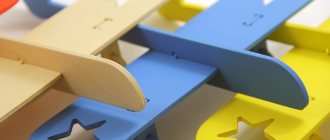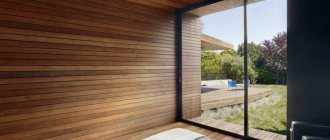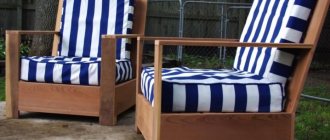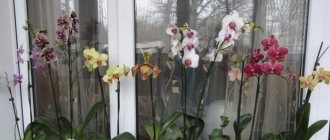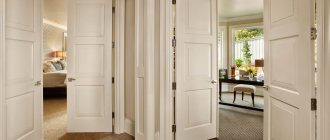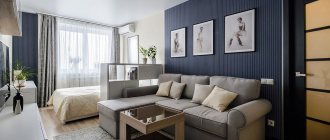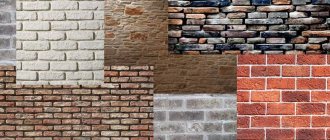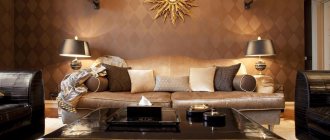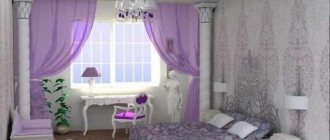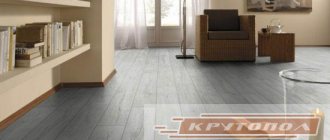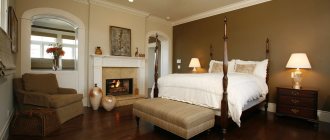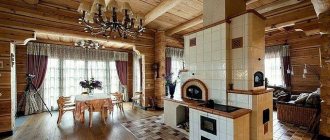Plywood is a fashionable design material in the interior. Previously, it was considered exclusively a building material for repairs. High possibilities for practical and aesthetic use make it very popular among modern designers, and such recognition is deserved. Plywood is easy to maintain and has characteristics such as flexibility, water resistance, durability and aesthetics. The collection of ideas using plywood in interior design is extensive.
Decorative finishing
Thanks to its special texture, plywood is a very impressive finishing material. It has a warm and bright color and is capable of creating eye-catching accents in the interior. Combinations of plywood with plaster, paint, and brickwork are successful for a modern style. The warmth of wood contrasts nicely with cool materials such as concrete and steel. Decorative interior decoration with plywood in country houses very expressively personifies the connection between man and nature. Such an interior can be very laconic and self-sufficient.
Furniture
The middle of the last century was the beginning of the introduction of this material into furniture production. The only furniture material that is more flexible than plywood is plastic. Furniture made from plywood is light, inexpensive and easy to process. This is a signature lifestyle style. The unusual designs are absolutely stunning and easy to use, the natural material makes the space warmer and more expressive. Many designers are experimenting with plywood and making very interesting and creative furniture designs.
Transforming walls
An unusual wall made of plywood, proposed by one of the designers, can be changed depending on the wishes of the owner of the house. It can become a fence for the kitchen, a screen for the bedroom or living room, and a library.
Details
Most interior parts can be made from plywood: stairs, stages, cabinets, partitions, racks and shelves. Plywood sheets of varying thicknesses and durability are used in a variety of applications and can withstand high impact loads. Window sills are also decorated with plywood; it looks fresh and unusual. This fashionable interior solution is very practical, since plywood has higher flexibility compared to wood and is easier to process.
Plywood's ability to bend is attractive to lamp manufacturers. This material is used to create minimalistic models with catchy shapes and textures. Featuring a variety of designs, the lamps fit perfectly into interiors of any style.
If you like the idea of using plywood in products of large shapes, it is better to start with small details - shelves, hooks or cute accessories. By adding coziness, they help make the atmosphere in the room more colorful, textured, fresh and full.
Classrooms
Even classrooms at a school, as well as auditoriums at a university or academy can be made from plywood. It is important that natural light enters such a room, since this is extremely important for the learning process.
For these purposes, you can use, for example, shutter doors, which, of course, are made of plywood.
What is the secret of attractiveness
Plywood in apartment interiors today is used in the manufacture of almost any item - furniture, partitions for zoning, and even sinks in the bathroom. These items are eco-friendly, practical and visually appealing. What is the secret of such popularity? People are becoming more demanding of the space around them, especially their homes. They prefer life in country houses or create “green corners” in the apartment. The use of plywood in the interior is based on the desire to have objects made from natural, environmentally friendly materials.
Walls in the shape of a barcode
Partitions between rooms in this house are, of course, an extremely unusual solution. It is convenient to use a similar design, for example, for a bathroom and a toilet, in order to separate them from each other without additional redevelopment.
The same idea can be used in the kitchen, bedroom, office and other rooms.
Budget alternative
Plywood in the interior of a house is a natural material that does not emit toxic substances and has a natural pattern. At the same time, it is cheaper than an array, and this allows you to make a more budget-friendly version of the final product. Plywood is relatively light in weight, highly durable due to its structure, and easy to handle. All these positive qualities help designers implement the most modern and unusual projects and create non-trivial forms. All this makes plywood an ideal material. Multifunctionality is another positive feature of plywood. It should be especially noted that it can be used in any premises, regardless of their purpose.
This could be the bathroom or the living room. The production of furniture, decor, interior items, lamps, partitions, decorative fences and podiums, zoning, as interior decoration of ceilings, walls and floors - plywood can be used everywhere. Smooth lines and curved shapes combine with items of any style. Thanks to this, plywood products easily fit into spaces of various configurations and volumes.
Advantages
The domestic building materials market offers a wide range of plywood, which makes it easy to choose the right option for a specific purpose. Various types of wood are used in its production. Main types of plywood:
- from several types of wood (combined);
- moisture resistant;
- bakelized (it is used in unfavorable climates, sea water, aggressive environments);
- marine;
- bent;
- laminated.
The color of plywood is also varied. Wood is considered a noble material, but you can’t get such curved and complex shapes from it! The issue of price is important.
What are plywood sheets?
Wall decoration with plywood
Plywood sheets are a construction material made from several layers. During its production, specialized natural wood veneer is glued together. As a rule, the amount of this veneer itself is odd, from 3 or more.
A distinctive feature of plywood sheets, which gives the canvas special strength, is that each layer is applied perpendicular to the previous one. This technique of forming the canvas does not allow the plywood to deform and crumble.
Today, the most popular are 2 types of canvas:
- moisture resistant - FC;
- increased moisture resistance - FSF.
The technical characteristics of the canvas are given in the table below.
| Characteristics of the canvas | FSB, BFS | Birch plywood sheets (aviation) | Construction sheets FSF, FBA, FC |
| Material Density | Up to 1000 kg/m2 | 500-650 kg/m2 | The type of tree affects the density |
| Humidity | 8% | 8% | 6-10% |
| Tensile strength | 80 MPa | 65-80 MPa | — |
| Water resistance of the canvas | High | Above average | High and medium |
| Sheet thickness | 5-18mm | 1-12mm | 1.5-18mm |
Related article: How to quickly and easily make a bird feeder from a plastic bottle?
Plywood is processed by lamination, which increases the durability and resistance of the material.
Decorative plywood can be made from both soft and hard wood. The material appears on the shelves of construction stores according to different types of fabric, grade, service life, price and appearance.
The most expensive representative of plywood are birch veneer sheets, but the most popular are plywood sheets made from softwood trees.
A little history
People appreciated the properties inherent in plywood more than five thousand years ago, but were undeservedly forgotten. Pressed veneer sheets were invented by the ancient inhabitants of Mesopotamia - they glued layers of wood together, making it more durable. However, it was not until the end of the 18th century that the first plywood was made in Great Britain. Then they began to produce furniture and interior items from it. In Russia, plywood was first used in industry: aircraft manufacturing, weapons technology, mechanical engineering, and musical instruments were made from it. And furniture was valued from solid wood. They preferred to make the “simpler” one from pressed sawdust. This feature of the worldview prevented designers and furniture manufacturers from appreciating all the benefits of plywood.
Design experiments
Furniture and interiors made of plywood have finally taken their rightful place. Examples of unimaginable design masterpieces are easy to find in Western apartments and houses.
In Russia, designers have been willingly using plywood lately. The search for new forms and possibilities in different styles led to free and unusual solutions. It is fashionable to make not only furniture and decor from plywood, but also decorative finishes for walls, ceilings and floors, covering it with varnish or paint. Plywood has a future. There are many ideas for using such a convenient material as plywood in the interior. Photos will inspire you to take action. Really high-quality and practical art objects are created from it by laser cutting. An original idea for an eco-style interior is a stylized wooden hanger. Ideal for your child's room! You can make not only children’s hangers yourself, but also original elements for any room in your home. Height, color, shape, functionality are limited by imagination and personal taste preferences.
Specifications
According to established standards, laminated plywood must have the following technical characteristics:
- Sheet thickness can be 4mm, 6mm, 9mm, 12mm, 18mm, 15mm, 20mm, 21mm, 30mm, 40mm;
- 120/240, 125/250. 244\122, 250/125 are standard sheet sizes in centimeters;
- 680-700 kg/m3 is an indicator of density;
- 10% humidity.
These parameters are standard for all types of high-quality laminated plywood. It is noteworthy that to create thick plywood, fewer sheets of veneer are used than to create thin plywood. At the same time, plywood, which is 20 mm thick, is actively used to create cabinet furniture. But the 30mm one has found application in finishing work.
In accordance with established technical conditions, factory cutting of sheets must be clearly at right angles. And chips and cracks are not allowed on the edges. The standard deviation from 90 °C along the length of the sheet is 2 millimeters for every meter.
The following table shows the permissible deviations in sheet length:
| — | Value (mm) | Tolerance |
| Length | 1525 | +-4 |
| Width | 3050 | +-4 |
| Thickness | 6,5 | +-4 |
| Thickness | 8 | +-0,5-0,7 |
| Thickness | 10, 12 | +-0,5-1,2 |
| Thickness | 15, 18, 21, 24 | +-1 |
| Thickness | 27, 30 | +-1-1,5 |
Laminated plywood can be made from birch or coniferous veneer. In terms of thermal conductivity, the quality of birch plywood is better. GOST 53920 2010 states that laminated birch plywood with increased moisture resistance corresponds to it. Its outer lining is a thermosetting polymer. The use of such plywood is permitted in a wide variety of building structures and in the engineering industry.
Weight
A sheet of plywood is not lightweight. So, with a thickness of 4 millimeters, a standard sheet of laminated birch veneer plywood, dimensions 2,440/1,220, weighs just over 8 kilograms.
The same sheet with a thickness of 9 millimeters will weigh more than 18 kilograms, but a 21 millimeter sheet will already weigh more than 41. And a plywood sheet with a thickness of 27 millimeters will weigh 53.5 kilograms. Weight indicators are indicated at a density of 665 kg/m3.
Handmade plywood item
Making such a tree hanger from plywood in the interior is not so easy, but anyone can do it if they have the appropriate tools in the house. This way you can significantly save money and time searching for a suitable stylistic option. And the biggest advantage of this idea is that the efforts will be rewarded with the joy of the child. A practical and original detail will appear in the nursery that will decorate the interior and serve as a source of pride. To create this tree you will need:
- two sheets of plywood;
- paper for applying templates;
- four metal brackets with screws included;
- hooks (it is better if they are wooden, but you can use any others that suit the design);
- saw or jigsaw, screwdriver, scissors;
- brushes and paint for painting the surface of plywood;
- pencils;
- sandpaper.
Draw on paper a drawing of a tree of the size you want your future product to be (crowns, branches, trunk-base). Try to get two sides that are symmetrical to each other, and draw all the lines smooth and rounded. Draw a line down the middle of your drawing. She will be central. Cut out the paper template. Attach it to the plywood and trace it like a stencil. Cut two identical trees using a jigsaw. In one of them, make a partial slit along the center line at the top, from the point where the “branches” begin, all the way to the bottom. Carefully sand the edges until perfectly smooth and then paint them in colors that match your preliminary sketch. After the paint has dried, assemble the finished pieces of the “tree” by inserting one element into the slot of the other. For better stability and for safety reasons, secure all sides of the joints with metal angles. The most enjoyable part of the job remains. Cut small decorative flowers or leaves from leftover plywood, paint them bright colors and place them on the “crown” of the tree hanger. Secure the hooks in places where they will be convenient for the little owner to use. The hanger is ready!
Plywood sheet: production features
A board glued together from 3-6 sheets of veneer is called sheet plywood. It is obtained from different types of deciduous trees from birch to alder, as well as from some types of coniferous trees.
The cost of the sheet directly depends on the type of wood. Birch plywood can surprise you with its high cost, while coniferous plywood, on the contrary, will please you with its affordable price.
Combining several types of wood allows you to reduce the cost of the material. This is done not only to save money, but also for aesthetic reasons: softwood veneer often has the illusion of relief and an intricate, beautiful pattern.
According to GOST, four types of plywood can be distinguished. Grade 1 allows for minor visual defects. The second grade does not exclude the presence of places on the plywood where glue has leaked, small cracks, or abrasions.
The presence of knots and wormholes in the sheet indicates that this is third-grade plywood. However, we should not forget that the quality of the product established by GOST also has limits: the total number of flaws should not exceed nine on one sheet. If you find a larger number of defects, uneven edges, then the plywood belongs to the fourth grade and is suitable only for the construction of industrial containers (containers, boxes for vegetables, etc.)
The dimensions of plywood sheets can vary from 1220 to 3050 mm. When purchasing a sheet, you should consider the purpose of its use. In accordance with GOST, the standard sheet length is 2440 mm, the width of which will be 1220 mm. But the most popular format is considered to be 1525x1525 mm.
Plywood sheets, in accordance with the state standard in force throughout the Russian Federation, can be from 6 to 30 mm thick. For the production of furniture, thin plywood is usually used, which does not exceed 9 mm in thickness.
If you need to make internal cladding of walls or floors, plywood with a thickness of 10 to 12 mm is ideal for you. For larger construction, it is better to take plywood from 15 mm.
An indispensable material in almost any construction is moisture-resistant plywood. It is as widespread as its usual variety. The difference between these types of plywood lies in its very name: moisture-resistant plywood can withstand exposure to moisture.
